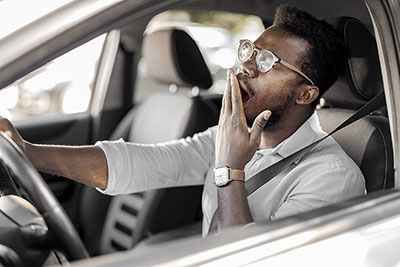Recognizing, preventing and responding to driver fatigue

Every year in Quebec, nearly a quarter of all road accidents resulting in injury1 involve driver fatigue. What are the signs of fatigue, how can we recognize them and how can we forestall these bouts of drowsiness? Let’s take a closer look.
What are the first signs of driver fatigue?
There’s no mistaking it: you’re yawning repeatedly! However, the signs of driver fatigue can vary from one person to the next. For example, you may:feel a burning sensation in your eyes;
have difficulty keeping your eyes open;
experience blurred vision or staring;
experience episodes of microsleep (drowsiness);
lose alertness for up to 15 seconds (which is an eternity on the road!);
react more slowly (such as braking at the last instant);
feel restless because of back and neck pain or discomfort;
forget the last few kilometres travelled (memory loss); and
have difficulty maintaining your speed or trajectory, etc
How to counteract fatigue and its symptoms?
As you’ve probably guessed, cranking up the radio, rolling down the car window or drinking an energy drink aren’t really effective ways of dealing with driver fatigue. So, what should you do if you notice the signs?
If possible, pass the steering wheel to another person;
Find a rest area, parking lot or other safe place to nap for 15 to 30 minutes and do a few exercises and stretches before getting back on the road.
Good to know: The shoulder of the road is not a safe place to take a nap, all the more so since it’s reserved for emergency situations.
Tip: Drink a small cup of coffee just before your nap, and the caffeine will take effect during it. While a nap can’t replace a good night’s sleep, it can help you stay on the road safely for longer.
What to do to prevent fatigue from getting worse?
Here are a few tips to help you complete your journey without an accident … but without any guarantee!
Reduce your speed;
Turn down the brightness of your dashboard;
Avoid fast lanes or monotonous roads;
Don’t force yourself to complete your drive at all costs. Knowing when to stop and resume later is, in most cases, the best decision you can make.
Feeling like you’re currently not in shape to drive? CAA-Quebec members can request CAA-Quebec Roadside Assistance for a safe ride home.
What are the dangers of driver fatigue?
Driver fatigue reduces concentration, impairs judgment and reflexes, and therefore affects the ability to drive. Although drowsiness while driving is not an “official” offence under the Highway Safety Code—neither a fine nor a penalty—for drivers of passenger vehicles, driver fatigue is the 3rd leading cause of death on the roads of Quebec, after alcohol and speeding, according to SAAQ road safety records. This disturbing finding encourages the CAA-Quebec Foundation to pursue its efforts to raise awareness on the issue and debunk the myths surrounding driver fatigue.
Good to know: If you are sleeping less than 5 hours a night, your risk of sleep deprivation increases. This is especially true if you are male and over the age of 50, as the risk of having an undiagnosed sleep disorder (sleep apnea) is higher for this demographic. A good night’s sleep should include a minimum of 7 hours per night.
How to prevent driver fatigue?
Without doubt, the best way to prevent driver fatigue is to maintain good sleep hygiene. As far as possible, avoid caffeine, nicotine or alcohol four to six hours before going to bed.
Do you have a long drive ahead of you or perhaps planning a road trip?
Sleep sufficiently in the days leading up to your trip;
Split your itinerary into multiple driving periods or days (with a break every two hours). Electromobilists can even take advantage of charging station stops to enjoy a power nap;
Eat light meals and hydrate regularly;
Avoid driving in darkness, at night or during hours usually associated with sleep. Instead, try to drive in the morning or between 3pm and 10pm.
Keep in mind: Managing fatigue should not be taken lightly. Take enough time to rest, rather than taking unnecessary risks on the road. By adopting a preventive approach (in fact, there are even personalized courses in defensive driving), you’ll be contributing to the safety of all road users, while enjoying safer, smoother journeys.
